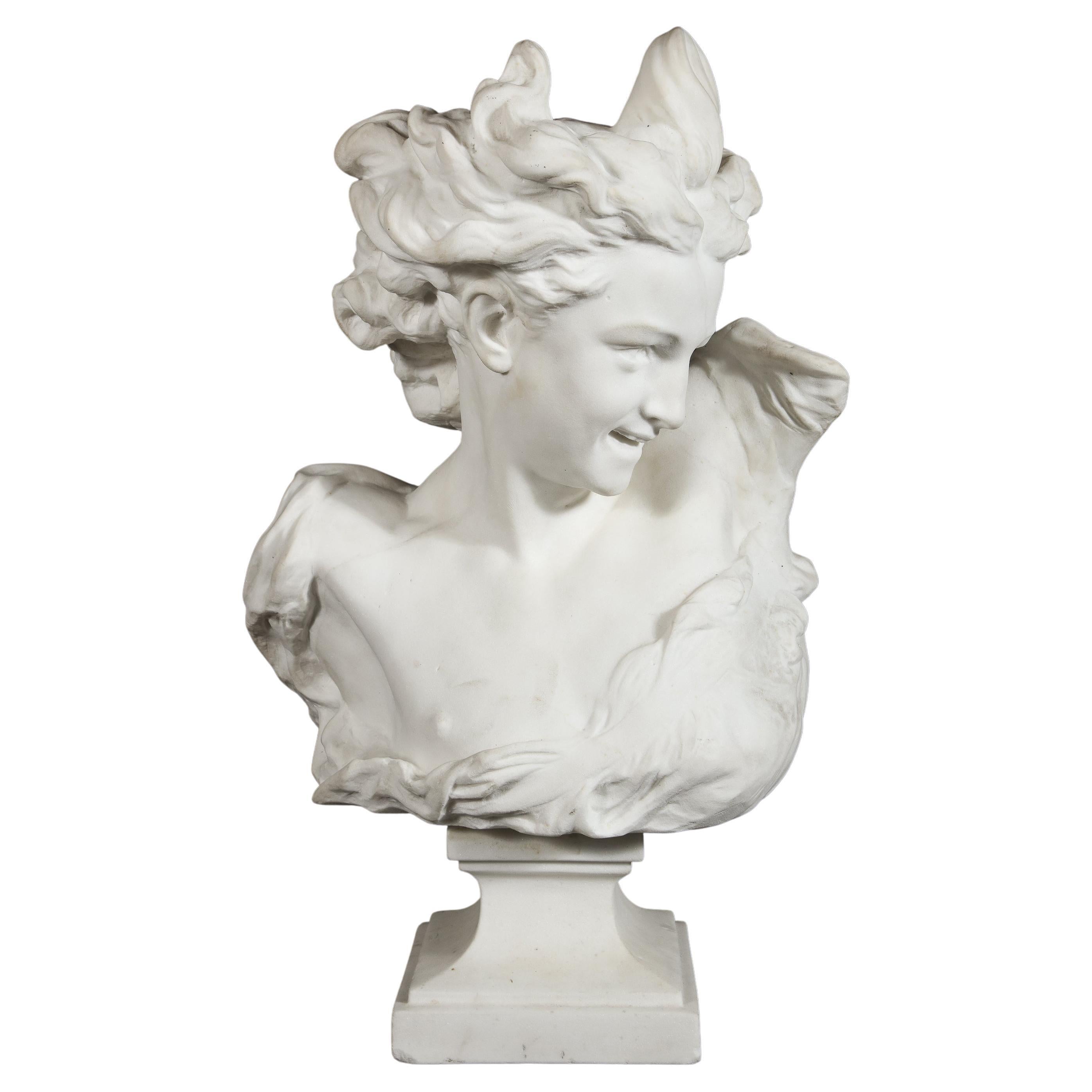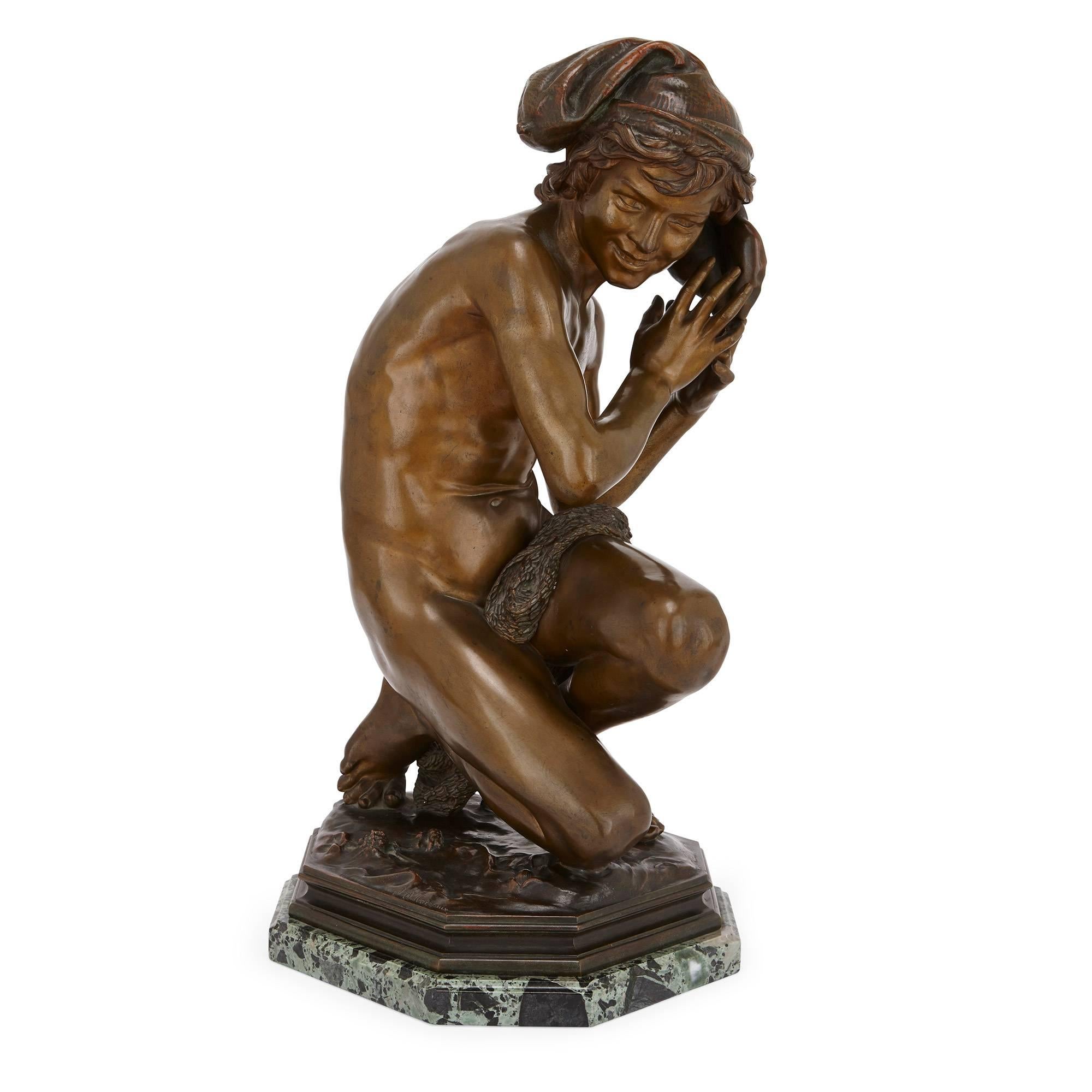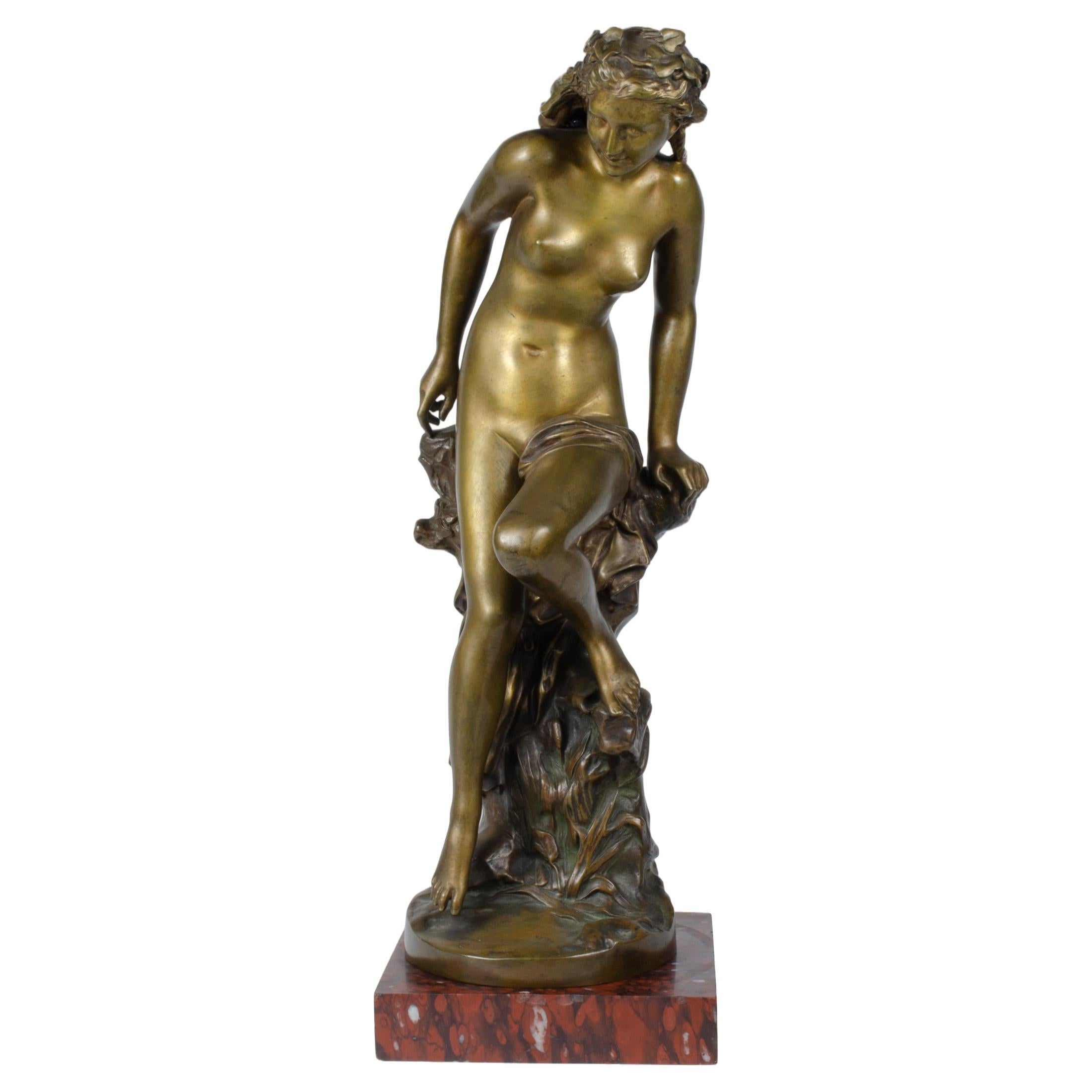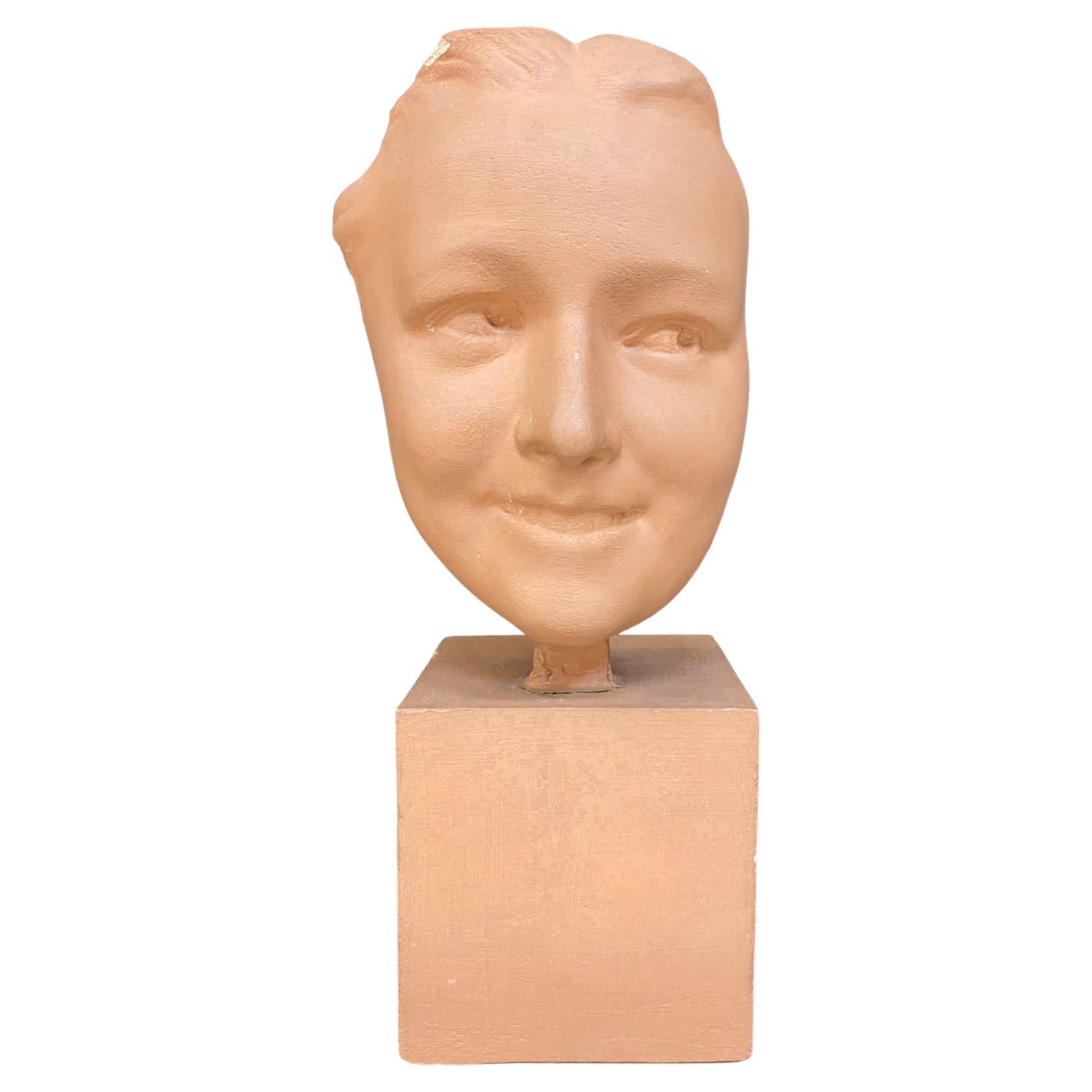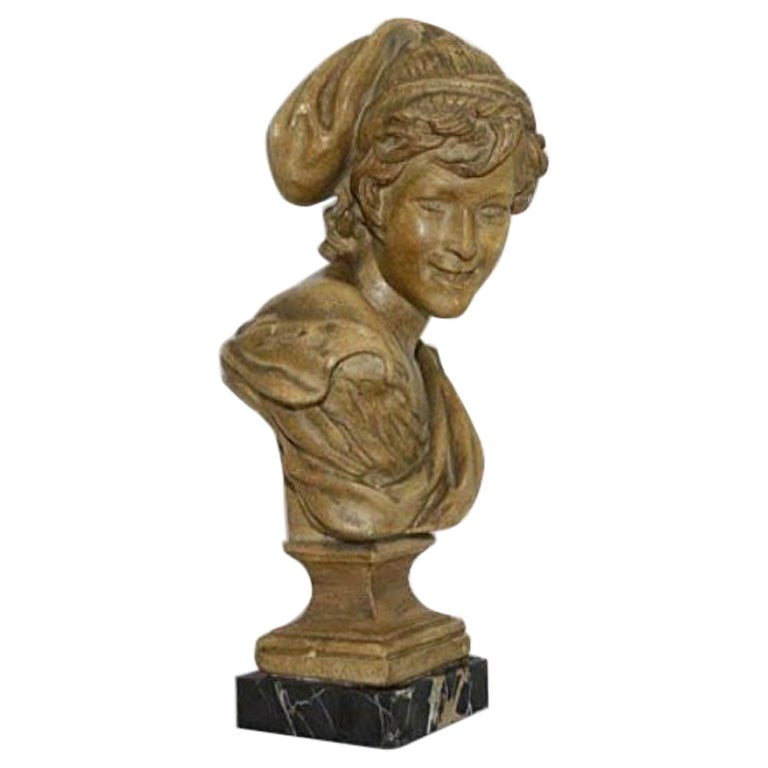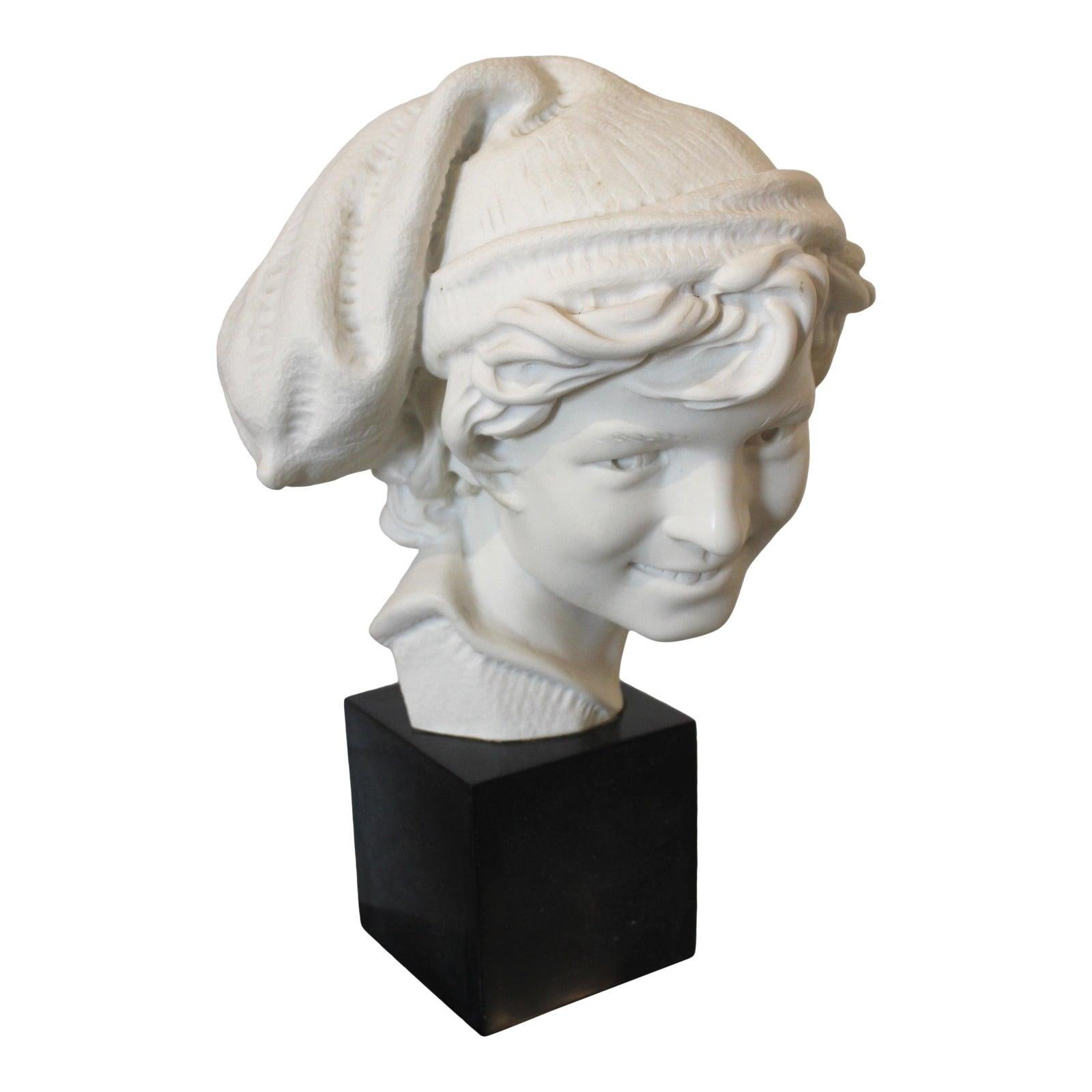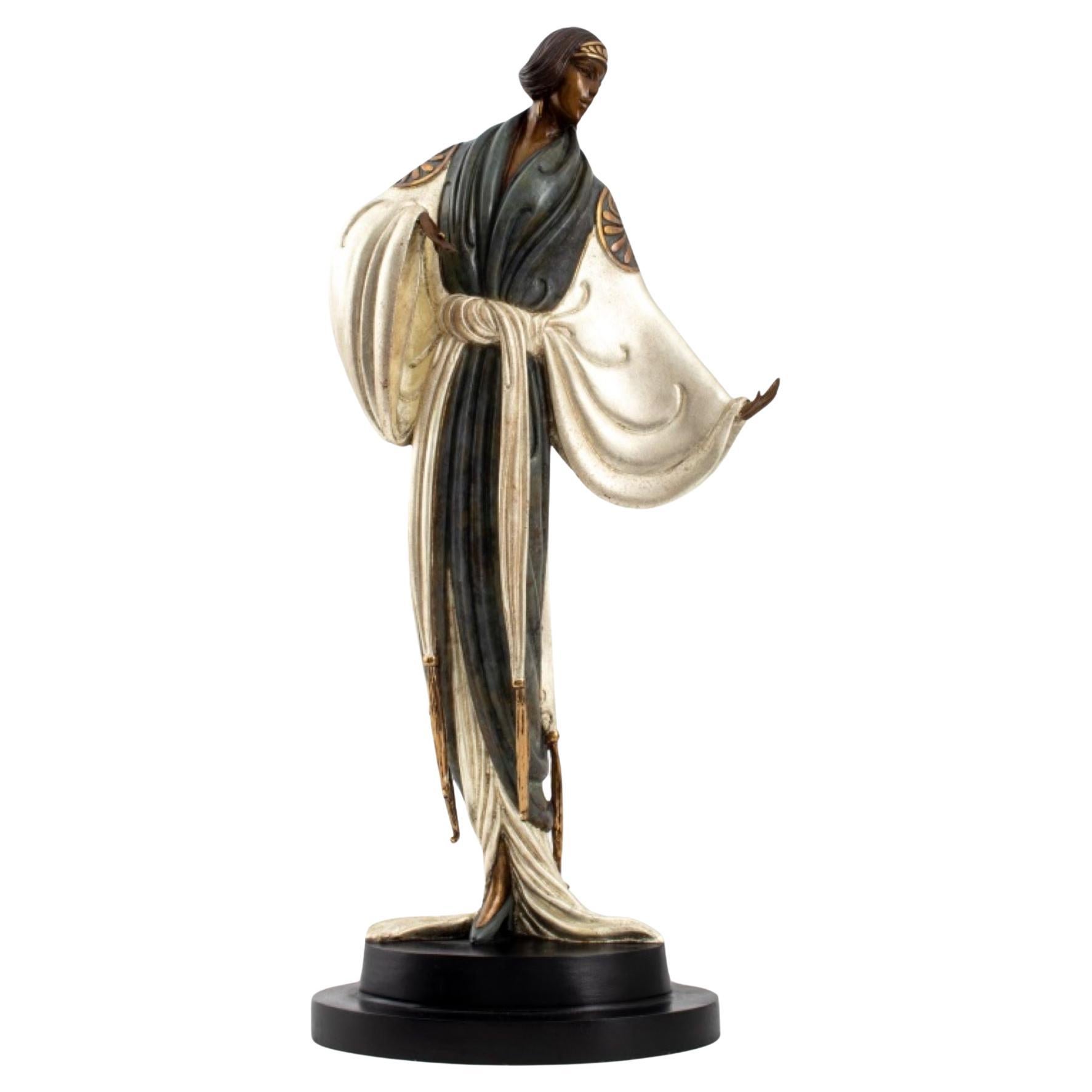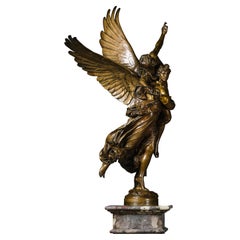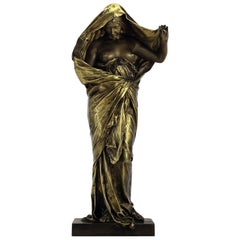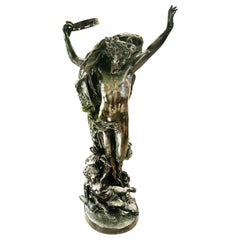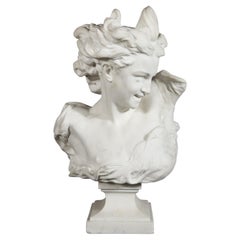
'Le Génie de la Danse, n°2', a Patinated Bronze Figure by Carpeaux, Dated 1872
View Similar Items
'Le Génie de la Danse, n°2', a Patinated Bronze Figure by Carpeaux, Dated 1872
About the Item
- Creator:Jean-Baptiste Carpeaux (Sculptor)
- Dimensions:Height: 33.47 in (85 cm)Width: 13.39 in (34 cm)Depth: 9.85 in (25 cm)
- Style:Napoleon III (Of the Period)
- Materials and Techniques:Bronze,Patinated
- Place of Origin:
- Period:
- Date of Manufacture:Dated 1872
- Condition:
- Seller Location:Brighton, GB
- Reference Number:Seller: B740501stDibs: LU1028014642772
Jean-Baptiste Carpeaux
Jean-Baptiste Carpeaux was born on 11 May, 1827 at Valenciennes, France the son of a mason. He initially studied at the Valenciennes art academy before the family moved to Paris. In 1844, Carpeaux entered the École des Beaux-Arts and also studied under François Rude and Francisque Duret. He started exhibiting at the Paris Salon in 1853 and won the Prix de Rome in 1854. Soon after, Carpeaux traveled to Italy, where he spent time in Rome studying at the French Academy. There, he produced several sculptures, which he exhibited at the Paris Salon in 1858. The critical acclaim Carpeaux received led to several important state and private commissions, helping him to achieve success and establishing his reputation. He returned to Paris in 1861 and went on to found his atelier in 1866, casting bronze editions of his sculptures. In the same year, Carpeaux received the chevalier of the Legion of Honour. He won first prize at the Exposition Universelle of 1867 in Paris. Carpeaux died on 12th October 1875, at George Barbu Știrbei's château in Bécon-les-Bruyères, outside Courbevoie near Paris. Examples of his work can be found at the National Museum, Warsaw, Metropolitan Museum of Art, New York and the Orsay Museum, Paris, France. Some of his public and architectural works can still be found at the Louvre Palace, Opera Garnier, Valenciennes and the Jardin du Luxemburg.
- Pair of Large Patinated Bronze Figural Torcheres Cast by Barbedienne, Dated 1872By Émile Guillemin, Ferdinand BarbedienneLocated in Brighton, West SussexA highly important pair of large patinated bronze figural torcheres by Émile Guillemin, cast by Ferdinand Barbedienne. French, dated 1872. Barbedienne Title: 'Deux Femmes, Indi...Category
Antique Late 19th Century French Floor Lamps
MaterialsBronze
- ‘Gloria Victis’, A Patinated Bronze Figural Group by Mercié, Cast by BarbedienneBy Ferdinand BarbedienneLocated in Brighton, West SussexA Patinated Bronze Figural Group of ‘Gloria Victis’ (‘Glory to the Vanquished’), Cast by Ferdinand Barbedienne from the Model by Marius-Jean-Antonin Mercié (French, 1845-1916). ‘Gloria Victis’ (‘Glory to the Vanquished’). Bronze, gilt and dark brown patina. Signed 'A. Mercié', with foundry inscription 'F. BARBEDIENNE, Fondeur. Paris.' and A. Collas reduction cachet. The integral base titled 'GLORIA VICTIS'. This cast is part of a limited edition by the Barbedienne Foundry. France. Circa 1880. ‘Gloria Victis’ is one of the most recognisable and important works of sculpture of the nineteenth century and a definitive image of France’s historic national identity. The figure of glory, winged and wearing armour, carries a dying young warrior heavenwards towards fame and immortality. The compositional daring of the group must be admired for balancing two figures on the minimal support of one foot, wings spread in the moment before taking flight. Mercié was a student at the French Academy of Rome when the Prussians invaded France in 1870. Shortly after the war had begun, he executed a group depicting the figure of Fame supporting a victorious soldier. When news reached Mercié in Rome that the French had surrendered, he decided to alter his group, replacing the victorious soldier with a defeated casualty, thus transforming an allegory of ‘Glory to the Victors’ into one of ‘Glory to the Vanquished’. Completed in 1872, a year after the defeat of French soldiers against the Prussian army, the statue personifies a defeated but heroic France. The title is also a reversal of the famous formula, ‘Vae Victis’ (Death to the Vanquished), which the Gallic general Brennus exclaimed upon defeating the Romans in 390 BC. The figure of the fallen soldier was thought to represent Henri Regnault, a fellow sculptor of Mercié who was killed on the last day of fighting. Measuring 317 cm. high the original group of ‘Gloria Victis’ was unveiled in plaster at the Salon of 1872. It was bought by the City of Paris for the sum of twelve thousand francs and then cast in bronze by Victor Thiébaut for eight thousand five hundred francs. The bronze was exhibited at the Salon in 1875 and first placed in Montholon Square in the 8th arrondissement. In 1884 it was transferred to the courtyard of the Hôtel de Ville and in 1930, it entered the collection of the Musée du Petit Palais, where it can be seen to this day. The Thiébaut Frères foundry also cast Gloria Victis bronzes for the cities of Niort (requested 1881) Bordeaux (requested 1883), Châlons-sur-Marne (today, Châlons-en-Champagne; requested 1890), and Cholet (requested 1901). In 1905, the Danish brewer and art collector Carl Jacobsen was permitted to have an exact cast made of the original sculpture in Paris, on condition that the base was made 2 cm lower and bore the inscription “Original tilhører Paris By” (The original belongs to the City of Paris). It too was cast by the Thiébaut Frères foundry. Gloria Victis was one of Jacobsen’s most important and his last acquisition. Today it has been returned to its original position in the Winter Garden at Glyptoteket, Copenhagen, Denmark. The full-size plaster was shown again at the Paris Expositon universelle of 1878 alongside a bronze reduction by Barbedienne. By this time Antonin Mercié had entered into a commercial edition contract with the Ferdinand Babedienne foundry to produce bronze reductions of Gloria Victis, his most famous work. Gloria Victis is first recorded to have been produced in three sizes and by 1886 Barbedienne’s ‘Catalogue des Bronzes D’Art’ lists six sizes measuring 3/5, 9/20, 7/20, 3/10, 6/25 and 2/10, of the original. These reductions were produced by an invention of Barbedienne’s business partner Achille Collas. The Collas reducing machine was a type of complex mechanical pantograph lathe that enabled sculpture to be mathematically measured and transcribed to scale, in the round, thus making a reduced size plaster from which a bronze could be cast. Mercié's modern sculpture had become an instant classic, even receiving an entry in the Nouveau Larousse Illustré. The success of the group undoubtedly lay in the fact that it was admired not just on an aesthetic level, but also on a patriotic level, particularly in its commemoration of heroism in defeat. Immediately ‘Gloria Victis’ was recognised as a national artwork, capable of arousing patriotism and casts were ordered from Barbedienne as local memorials commemorating the war’s dead for cities across France. ‘Gloria Victis’ was considered so much a part of France’s national identity that for the 1900 Paris Exhibition, Ferdinand Barbedienne’s nephew Gustave Leblanc, loaned a bronze example to feature as part of l’Exposition centennale de l’art français. Literature: For an interesting account of the process of creating a reduction in bronze of the Gloria Victis by Barbedienne and illustrations of the casting and finishing of the bronze see: 'Ferdinand Barbedienne': Theodore Child; Harper's new monthly magazine, Volume 73, Issue 436, September 1886. ‘Contemporary French Sculptors’: The Century, Volume 33, Issue 3, Jan 1887. ‘Modern French Sculpture’: Harper's new monthly magazine, Volume 76, Issue 452, January 1888. S, Lami, ‘Dictionnaire des sculpteurs de l'Ecole française au dix-neuvième siècle’, Tome III. G.-M., Paris, 1914, p. 432. Peter Fusco and H.W. Janson, The Romantics to Rodin: French Nineteenth Century Sculpture from North...Category
Antique 19th Century French Figurative Sculptures
MaterialsBronze
- Bronze Figure of 'La Nature Se Dévoilant Devant La Science'By Louis Ernest BarriasLocated in Brighton, West SussexBronze figure of 'La Nature se dévoilant devant la Science' by Louis-Ernest Barrias. Inscribed 'E. Barrias' and with Susse Frères foundry cachet and further Susse inscription. ...Category
Early 20th Century French Figurative Sculptures
MaterialsBronze
- Patinated Bronze Figure of a Native American Scout by Carl Kauba, circa 1910By Carl KaubaLocated in Brighton, West SussexA fine patinated bronze figure of a Native American scout by Carl Kauba. Austrian, circa 1910. Signed in the cast 'Carl Kauba'. The figure cast as an American Native scou...Category
Early 20th Century Austrian Figurative Sculptures
MaterialsBronze
- 'Bacchantes', a Fine Patinated Bronze Figural Group After Clodion, circa 1870By Claude Michel ClodionLocated in Brighton, West Sussex'Bacchantes', a fine patinated bronze figural group after Claude Michael Clodion, French (1738-1814). French, circa 1870. Signed 'Clodion' to the base and inscribed 'BACCHANTE...Category
Antique Late 19th Century French Figurative Sculptures
MaterialsBronze
- Large Multi-Patinated Bronze Figure of an Arab Warrior by Henri-Honoré PléBy Henri Honoré PléLocated in Brighton, West SussexA Large and Important Multi-Patinated Bronze Figure of an Arab Warrior by Henri Honoré Plé. Signed Henri Plé to the base. The figure is finely modelled as an Arab warrior, with sw...Category
Antique 19th Century French Figurative Sculptures
MaterialsBronze
- Large Jean-Baptiste Carpeaux 1872 bronze "Le genie de la Danse" france.By Jean-Baptiste CarpeauxLocated in Rio De Janeiro, RJIncredible rare and large bronze for JEAN-Baptiste CARPEAUX 1872 representing "Le GENIE de la Danse".Category
Antique 1870s French Empire Figurative Sculptures
MaterialsBronze
- Jean-Baptiste Carpeaux Marble Bust of "Genie De La Danse"By Jean-Baptiste CarpeauxLocated in New York, NYJean-Baptiste Carpeaux (French, 1827–1875) white marble bust of "Genie De La Danse" (Spirit of the Dance), 19th century. Carpeaux was a French sculptor and painter during the Second Empire under Napoleon III. This bust from La Danse was the first detail of the group to be individually edited. Carpeaux frequently offered terracotta editions of the bust in his public sales from 1871 to 1874. Extremely fine quality, very well carved, Signed 'Carpeaux 'on the right lower side. Measures: 25" high x 16" wide x 11" deep. Good condition. No damages noted. Ready to place. Bibliography: Michel Poletti and Alain Richarme, 'Jean-Baptiste Carpeaux sculpteur, catalog raisonné of the edited...Category
Antique Late 19th Century French Napoleon III Figurative Sculptures
MaterialsMarble
- Antique French Patinated Bronze Sculpture of a Young Fisher Boy by CarpeauxBy Susse Freres, Jean-Baptiste CarpeauxLocated in London, GBThis beautiful patinated bronze sculpture was designed by Jean-Baptiste Carpeaux, and cast by the Susse Frères foundry. The work portrays a young Neapolitan fisherboy, who sits on a naturalistic base, crouched holding a shell to his ear. The work is signed 'J. B. Carpeaux' and has Susse Frères foundry marks, and is set on a veined green marble plinth. This stunning antique French bronze sculpture presents a unique opportunity to collect one of the original models of the young Neapolitan fisherboy by Jean-Baptiste Carpeaux. The original model for this delicate antique bronze sculpture of a fisher boy...Category
Antique 19th Century French Napoleon III Figurative Sculptures
MaterialsMarble, Bronze
- Sculpture “La Frileuse” by Jean-Baptiste CarpeauxBy Jean-Baptiste CarpeauxLocated in Ciudad Autónoma Buenos Aires, CSculpture “La Frileuse” by Jean-Baptiste Carpeaux (1827-1875). It is made of gilded bronze supported on a red marble base. Signed JB Carpeaux, P B, Susse Frères, Editeuns Paris, Suss...Category
Antique 1860s French Art Nouveau Figurative Sculptures
MaterialsMarble, Bronze
- After Jean-Baptiste Carpeaux "Woman's Face", Patinated PlasterBy Jean-Baptiste CarpeauxLocated in Saint-Ouen, FRAfter Jean-Baptiste CARPEAUX (1827 - 1875). "Woman's face", patinated plaster sculptureCategory
Antique Early 1900s French Neoclassical Figurative Sculptures
MaterialsPlaster
- Jean-Baptiste Carpeaux, L'Espiegle, Verdigris Bronze Bust Anna FoucartBy Jean-Baptiste CarpeauxLocated in Germantown, MDJean-Baptiste Carpeaux (French 1827-1975) L'Espiegle "The Mischief Maker" Patinated Verdigris Bronze Bust of Anna Foucart smiling. Measures 10" wide , 10" deep and 19.5" tall. Bor...Category
Antique Late 19th Century French Neoclassical Busts
MaterialsBronze

